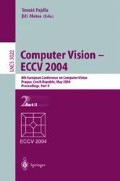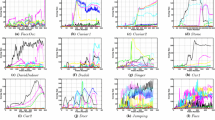Abstract
Visual tracking, in essence, deals with non-stationary data streams that change over time. While most existing algorithms are able to track objects well in controlled environments, they usually fail if there is a significant change in object appearance or surrounding illumination. The reason being that these visual tracking algorithms operate on the premise that the models of the objects being tracked are invariant to internal appearance change or external variation such as lighting or viewpoint. Consequently most tracking algorithms do not update the models once they are built or learned at the outset. In this paper, we present an adaptive probabilistic tracking algorithm that updates the models using an incremental update of eigenbasis. To track objects in two views, we use an effective probabilistic method for sampling affine motion parameters with priors and predicting its location with a maximum a posteriori estimate. Borne out by experiments, we demonstrate the proposed method is able to track objects well under large lighting, pose and scale variation with close to real-time performance.
Chapter PDF
Similar content being viewed by others
Keywords
These keywords were added by machine and not by the authors. This process is experimental and the keywords may be updated as the learning algorithm improves.
References
Black, M.J., Jepson, A.D.: Eigentracking: Robust matching and tracking of articulated objects using view-based representation. In: Buxton, B., Cipolla, R. (eds.) ECCV 1996. LNCS, vol. 1064, pp. 329–342. Springer, Heidelberg (1996)
Morency, L.P., Rahimi, A., Darrell, T.: Adaptive view-based appearance models. In: Proceedings of IEEE Conference on Computer Vision and Pattern Recognition, vol. 1, pp. 803–810 (2003)
Birchfield, S.: Elliptical head tracking using intensity gradient and color histograms. In: Proceedings of IEEE Conference on Computer Vision and Pattern Recognition, pp. 232–237 (1998)
Wu, Y., Huang, T.: A co-inference approach for robust visual tracking. In: Proceedings of the Eighth IEEE International Conference on Computer Vision, vol. 2, pp. 26–33 (2001)
Isard, M., Blake, A.: Contour tracking by stochastic propagation of conditional density. In: Buxton, B., Cipolla, R. (eds.) ECCV 1996. LNCS, vol. 1064, pp. 343–356. Springer, Heidelberg (1996)
La Cascia, M., Sclaroff, S., Athitsos, V.: Fast, reliable head tracking under varying illumination: An approach based on registration of texture-mapped 3D models. IEEE Transactions on Pattern Analysis and Machine Intelligence 22, 322–336 (2000)
Black, M.J., Fleet, D.J., Yacoob, Y.: Robustly estimating changes in image appearance. Computer Vision and Image Understanding 78, 8–31 (2000)
Harville, M.: A framework for high-level feedback to adaptive, per-pixel mixture of Gaussian background models. In: Heyden, A., Sparr, G., Nielsen, M., Johansen, P. (eds.) ECCV 2002. LNCS, vol. 2352, pp. 531–542. Springer, Heidelberg (2002)
Adelson, E.H., Bergen, J.R.: The plenoptic function and the elements of early vision. In: Landy, M., Movshon, J.A. (eds.) Computational Models of Visual Processing, pp. 1–20. MIT Press, Cambridge (1991)
Belhumeur, P.N., Kriegman, D.J.: What is the set of images of an object under all possible illumination conditions. International Journal of Computer Vision 28, 1–16 (1998)
Hallinan, P.: A low-dimensional representation of human faces for arbitrary lighting conditions. In: Proceedings of IEEE Conference on Computer Vision and Pattern Recognition, pp. 995–999 (1994)
Basri, R., Jacobs, D.: Lambertian reflectance and linear subspaces. In: Proceedings of the Eighth IEEE International Conference on Computer Vision, vol. 2, pp. 383–390 (2001)
Lucas, B., Kanade, T.: An iterative image registration technique with an application to stereo vision. In: Proceedings of International Joint Conference on Artificial Intelligence, pp. 674–679 (1981)
Black, M.J., Fleet, D.J., Yacoob, Y.: A framework for modeling appearance change in image sequence. In: Proceedings of the Sixth IEEE International Conference on Computer Vision, pp. 660–667 (1998)
Brand, M.: Morphable 3D models from video. In: Proceedings of IEEE Conference on Computer Vision and Pattern Recognition, vol. 1, pp. 315–322 (2001)
Brand, M.: Incremental singular value decomposition of uncertain data with missing values. In: Heyden, A., Sparr, G., Nielsen, M., Johansen, P. (eds.) ECCV 2002. LNCS, vol. 2350, pp. 707–720. Springer, Heidelberg (2002)
Levy, A., Lindenbaum, M.: Sequential Karhunen-Loeve basis extraction and its application to images. IEEE Transactions on Image Processing 9, 1371–1374 (2000)
Comaniciu, D., Meer, P.: Mean shift: A robust approach toward feature space analysis. IEEE Transactions on Pattern Analysis and Machine Intelligence 24, 603–619 (2002)
Comaniciu, D., Ramesh, V., Meer, P.: Kernel-based object tracking. IEEE Transactions on Pattern Analysis and Machine Intelligence 25, 564–577 (2003)
Hager, G., Belhumeur, P.: Real-time tracking of image regions with changes in geometry and illumination. In: Proceedings of IEEE Conference on Computer Vision and Pattern Recognition, pp. 403–410 (1996)
Shashua, A.: Geometry and Photometry in 3D Visual Recognition. PhD thesis, Massachusetts Institute of Technology (1992)
De la Torre, F., Gong, S., McKenna, S.J.: View-based adaptive affine tracking. In: Burkhardt, H.-J., Neumann, B. (eds.) ECCV 1998. LNCS, vol. 1406, pp. 828–842. Springer, Heidelberg (1998)
Jepson, A.D., Fleet, D.J., El-Maraghi, T.F.: Robust online appearance models for visual tracking. In: Proceedings of IEEE Conference on Computer Vision and Pattern Recognition, vol. 1, pp. 415–422 (2001)
Hager, G.D., Belhumeur, P.N.: Efficient region tracking with parametric models of geometry and illumination. IEEE Transactions on Pattern Analysis and Machine Intelligence 20, 1025–1039 (1998)
Jordan, M.I. (ed.): Learning in Graphical Models. MIT Press, Cambridge (1999)
Tipping, M.E., Bishop, C.M.: Probabilistic principal component analysis. Journal of the Royal Statistical Society, Series B 61, 611–622 (1999)
Roweis, S.: EM algorithms for PCA and SPCA. In: Jordan, M.I., Kearns, M.J., Solla, S.A. (eds.) Advances in Neural Information Processing Systems 10, pp. 626–632. MIT Press, Cambridge (1997)
Champagne, B., Liu, Q.G.: Plane rotation-based EVD updating schemes for efficient subspace tracking. IEEE Transactions on Signal Processing 46, 1886–1900 (1998)
Golub, G.H., Van Loan, C.F.: Matrix Computations. The Johns Hopkins University Press, Baltimore (1996)
Jolliffe, I.T.: Principal Component Analysis. Springer, Heidelberg (2002)
Vermaak, J., Pérez, P., Gangnet, M., Blake, A.: A framework for high-level feedback to adaptive, per-pixel mixture of Gaussian background models. In: Heyden, A., Sparr, G., Nielsen, M., Johansen, P. (eds.) ECCV 2002. LNCS, vol. 2350, pp. 645–660. Springer, Heidelberg (2002)
Author information
Authors and Affiliations
Editor information
Editors and Affiliations
Rights and permissions
Copyright information
© 2004 Springer-Verlag Berlin Heidelberg
About this paper
Cite this paper
Ross, D., Lim, J., Yang, MH. (2004). Adaptive Probabilistic Visual Tracking with Incremental Subspace Update. In: Pajdla, T., Matas, J. (eds) Computer Vision - ECCV 2004. ECCV 2004. Lecture Notes in Computer Science, vol 3022. Springer, Berlin, Heidelberg. https://doi.org/10.1007/978-3-540-24671-8_37
Download citation
DOI: https://doi.org/10.1007/978-3-540-24671-8_37
Publisher Name: Springer, Berlin, Heidelberg
Print ISBN: 978-3-540-21983-5
Online ISBN: 978-3-540-24671-8
eBook Packages: Springer Book Archive




